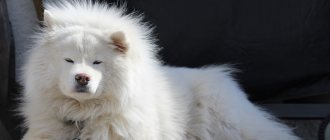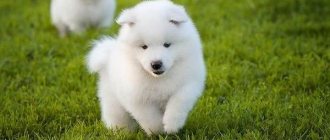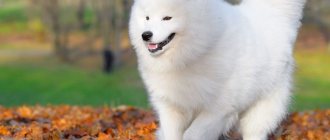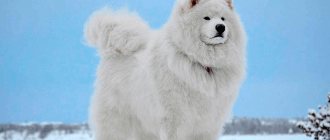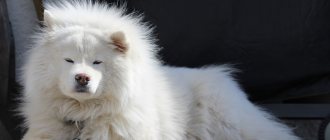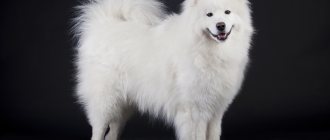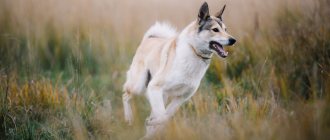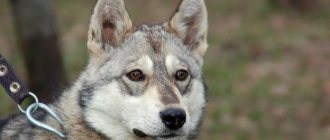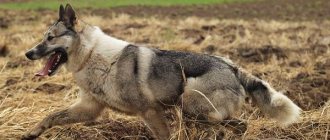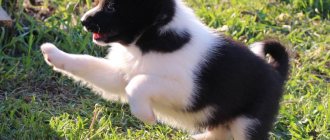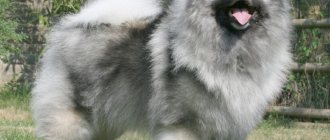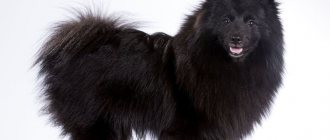The Samoyed is one of the oldest dog breeds, born in the harsh northern climate.
The name itself - “Samoyed” - indicates the relationship to the Samoyed tribes, from which this breed originated.
Samoyeds themselves are similar to polar bear cubs, and their character is characterized by playfulness and cheerfulness, combined with high intelligence.
Breed characteristics
| Short description | |
| Origin: | Russia, northern region (Siberia, circumpolar region) |
| Conditions of detention: | In an apartment or in a country house |
| Purpose: | Sled dog, partner |
| Color: | Pure white, minor fawn markings allowed |
| Wool length: | Medium, thick, double |
| Adult dog size: | Males: height from 54 cm to 60 cm; weight from 25 kg to 30 kg Females: height from 50 cm to 56 cm; weight from 17 kg to 25 kg |
| Average life expectancy: | 12-15 years |
| Walk: | 2 times a day, lasting at least 1 hour each |
| Physical activity needs: | High intensity, requires active exercise, predominantly aerobic in nature |
| Fédération Cynologique Internationale (FIC) classification: | The breed was recognized by the FCI in 1959. Group 5. Spitz and primitive breeds/section 1. Northern sled dogs |
| Puppy price: | Average cost:
|
Nutrition
Samoyeds love to eat. The Samoyed husky puppy eats twice a day in large portions. Samoyeds also drink a lot, so they should always have access to clean water. It is easier to feed with premium food for medium-sized dogs - this brand is usually recommended by breeders.
It is much more difficult to feed with natural food. 70 percent of the diet should be lean meat of turkey, chicken, and rabbit. It is important to add cereals to it: buckwheat, millet, oats. Raw vegetables in the form of cabbage, carrots, pumpkins, cucumbers, lettuce, and zucchini are also added there.
The lack of calcium must be replenished with fermented milk products: cottage cheese, sugar-free yogurt, kefir, whey, yogurt. Give fish once a week, but only sea fish. Also once a week - one raw egg.
Semi-cooked by-products. For adult dogs, a single meal is sufficient, but it must fully meet the daily need for vitamins, minerals and proteins.
Samoyeds are naturally healthy
History of the origin of the species
There are many legends and guesses regarding the history of the origin of the Samoyed dog . According to one version, they accompanied the small northern Samoyed tribes, which are usually classified as a Finno-Ugric group. The ancestors of the Nenets, Enets and other peoples settled in the territories of the modern Nenets and Yamalo-Nenets Autonomous Okrugs, as well as partially in the Tyumen region and Taimyr in the 11th century BC.
The primitive peoples inhabiting the Far North in that era were hunters and gatherers . Given the harsh climatic conditions, the need naturally arose to involve a dog in the main types of human activities. There is an assumption that a wolf adapted to the Arctic cold was used for these purposes. However, there is no rigorous scientific evidence to support this point of view.
The hypothesis of the domestication of the wolf can only be supported by the thick white fur and characteristic elongated muzzle of the modern Samoyed. The geographical limitations of the region led to the fact that by the beginning of the 19th century AD. The dog's genotype was considered completely lost. Thus, it is generally accepted that modern individuals have nothing in common with their ancestors.
What is known for certain is that in 1889, the English naturalist Ernst Kilbrun Scott, after living for several months among the Samoyed tribe, brought a dog puppy to his homeland. Later, two more puppies were brought from the Western Urals - a male and a female. It was these individuals that served as the basis for selection, and the breed quickly spread to the western part of the European continent. Samoyeds returned to Russia relatively recently.
Now the number of animals, according to various estimates, ranges from 1800 to 2500 specimens.
Why is the Samoyed husky called that?
Many people are interested in where such a strange, and even slightly ominous name for the breed “Samoyed Laika” came from. There are two main versions of the origin of this name.
Generally recognized (official):
Such animals were bred by northern peoples belonging to the Samoyed group (Nenets, Enets, Selkups, Laplanders). In the old days they were called “samoyed”, “self-integrated” - that is, “those who live separately, on their own, alone.” And the dogs that belonged to them began to be called the same by analogy.
Samoyed in winter
Without any scientific confirmation (unofficial):
When the snow-white Samoyeds were harnessed to a sled, they were not noticeable at all against the background of snow. And the impression was created that the sleigh moved without outside help. And for this reason, such sleds were called “self-eating”, or otherwise “samoyeds”. Subsequently, the dogs themselves began to be called this way.
Distinctive features
Samoyeds are well-recognized dogs . According to the unofficial classification, which dates back to the beginning of the 20th century, they are conventionally divided into three subspecies. Thanks to E.K. Scott's descriptions include the following types:
- Bear-shaped;
- Fox-shaped;
- Wolf-like types.
The main difference is the shape of the head, corresponding to the name. All other exterior characteristics have the same attributes:
- The head is very powerful.
- The skull is wide (bear-shaped type) or wedge-shaped (fox-shaped and wolf-shaped types).
- The frontal part is wide, slightly convex when viewed from the front.
- The ears are small; wide, high stance; the ends are slightly rounded; the inner surface is completely covered with thick hair.
- The muzzle is deep, the narrowing towards the nose is slight.
- The nose is wedge-shaped.
- The nose is black or dark brown; in winter it can completely lose color; there must be a black border.
- The eyes are dark brown, deep set, wide set, almond shaped.
- bite .
- The teeth are strong, a complete set of 42 pieces.
- The jaws are powerful.
- The lips fit tightly, forming a recognizable “smile.”
- The neck is strong and relatively short.
- The body is stocky.
- The limbs are straight, parallel, strong muscles are clearly expressed.
- The coat is medium length, straight, very dense, shiny, double coat; there is a short, dense undercoat; noticeably fuller around the neck, shorter on the limbs; characteristic “breeches” on the hips; there is protective hair between the fingers; “ruffles” during frosty, snowy periods; has self-cleaning properties.
- The tail is fluffy and saber-shaped when moving.
- The color is pure white, minor fawn markings are allowed; the setting is high.
Why does the Samoyed have a pink nose?
Over varying periods of time, a Samoyed's nose may become discolored and turn pink. As a rule, this happens in winter. At the same time, however, a dark edging is always preserved around the nose. This feature is inherent in northern dog breeds. There is even such a thing as a “snow nose”. The scientific name for this condition is hypopigmentation.
According to experts, the following factors may be the reasons for the color change:
- In winter, the Samoyed dog likes to dig snow with its nose, as a result of which the top layer of the lobe is peeled off mechanically
- the dark color appears due to an elementary tan, which appears with the onset of the spring sun
Hypopigmentation does not have any negative effect on the dog. You can enhance the pigmentation of the nose without waiting for spring by adding the following to your animal’s diet:
- seaweed
- vitamin E
- Brewer's yeast
- liver and kidneys
Photo of an adult dog
Application
If earlier Samoyeds, like Weimaraners and Shorthaired Pointers , were used as hunters, now this function has long been lost due to the hunting instinct lost over time.
You can find out about other hunting dog breeds here:
But in the north, these dogs still remain excellent riding animals, capable of carrying slightly more weight than their own.
Due to their high social activity and goodwill, Samoyed huskies also cannot be used as guard dogs.
They remain wonderful companions for people and are also ideal for families with children. In addition, the Samoyed gets along well with other animals in the house.
In this case, there is no need to worry about the safety of all household members, since the dog will in no case show an aggressive attitude.
Friendliness is one of the main qualities of Samoyeds
Photos of puppies
Possible diseases
With proper care and competent care, Samoyeds can live up to 15-16 years, delighting their owners with their presence. Reviews indicate that a Samoyed husky with a good pedigree can live without disease. And the typical ailments of the breed are, first of all, problems with the joints.
The leader in this list is dysplasia that occurs with age. If the problem is advanced, the dog may lose control of its paws. This disease is followed by arthritis - joint inflammation that affects the hip, elbow, and shoulder bones. It is not possible to completely get rid of it, but therapy will help stop the disease.
Among the problems of the gastrointestinal tract, volvulus of the stomach and intestines comes first. The disease is fatal, usually has an acute condition and requires immediate hospitalization of the dog.
It occurs either due to congenital abnormalities in the structure of the ligaments, or due to excessive physical exertion immediately after eating. Prevention - the dog is at rest for 30 minutes after breakfast or dinner.
Ophthalmic diseases include cataracts. Basically, the dog acquires it with age. Glaucoma may also develop. It is usually a consequence of untreated cataracts, but can also occur on its own. In addition, the breed suffers from retinal atrophy, which results in blindness. All diseases require medical intervention.
Diabetes may occur due to hormonal imbalances. Its symptoms include frequent and copious urination. It can even lead to death if the dog is not examined by a veterinarian in time. Bitches may develop urinary tract infections after estrus or mating with a sick partner.
Among heart problems, there is a pathology such as aortic stenosis, and among hearing diseases, deafness, which is either congenital or develops in the first months of a dog’s life.
Features of character and behavior
Despite the harsh, cold climate in which the breed was formed, modern Samoyeds, otherwise called Samoyed Laikas, bear little resemblance to their ancestors. They are extremely trusting, friendly and playful.
The best activity is considered to be a fun game in a large group of people, including small children. Based on these characteristics, you should not expect the Samoyed to display watchdog or security qualities.
The barking with which they unlimitedly accompany their running around serves rather to attract attention. They love to rush around, fuss, and are able to run far. Therefore, owners need to keep their pets in sight while walking. Hunting qualities have been lost. Movements are free, with a noticeable push of the limbs.
Advantages
Samoyeds have considerable advantages:
- Great companions;
- They have a good-natured, cheerful, playful character;
- Energetic, active, love movement;
- Smart and easy to train;
- Unpretentious, suitable for keeping in an apartment;
- They do not have a dog smell;
- Wool has the property of self-cleaning;
- Absolute absence of aggressive behavior;
- Great for inexperienced owners;
- High life expectancy;
- They get along well with small children and pets.
Flaws
The Samoyed dog has practically no disadvantages. The main problems associated with the breed include the following:
- Increased attention must be paid to coat care.
- The need for high intensity and duration of exercise.
- Expressed contact, including with strangers. This may cause the loss of the dog. Owners must be extremely careful when walking.
- On the street they can run after yard cats. To avoid this behavior, your pet should be trained from puppyhood.
- Heavy shedding.
Price
The price of a Samoyed husky varies depending on several factors. A pet-class puppy, which is not suitable for breeding and exhibitions, costs about 15 thousand rubles.
Show and breeding class dogs cost up to 50 thousand rubles. But it is not difficult to buy a Samoyed in Russia and the CIS countries - there are many nurseries in the regions and the capital where puppies with passports and vaccinations are sold.
A puppy that costs less than the specified amount is not worth buying. Firstly, it may be a cross with a Samoyed or not a Samoyed at all - it is difficult to determine the breed from small puppies. Secondly, if it is a crossbreed, then it may have congenital diseases that are difficult to cure.
By the way, small puppies aged a month or two are cheaper. The fact is that possible defects and diseases appear at the age of four to five months, some of them are difficult to predict. Therefore, a small puppy is a “black box” for the breeder and the buyer.
The black color of Samoyeds is not recognized by the standard
Care and maintenance
Representatives of this breed are very unpretentious, able to adapt well to both heat and cold. This is their absolute advantage over other dogs. They are well suited for keeping in an apartment, but can also live in an enclosure.
Due to high activity and sociability, the preferred location is next to the owner.
Bathing a Samoyed is a simple procedure that only needs to be done once a year. For washing, special shampoos are usually used, without additives. If your pet resists, you can use dry cleaning products.
The presence of protective fur between the toes requires thorough washing of the paws every day, even after a walk in the dry, hot season.
The condition of the teeth is monitored once a week. The best way to prevent the appearance of tartar is to accustom your puppy to the procedure of brushing its teeth . Given the restless nature of the pet, the process may present some difficulties. It is very important not to follow the lead of the snow-white, fluffy miracle and persistently remove plaque. To do this, you can use special brushes that are placed on your finger, or dental sponges for dogs. Additionally, it is recommended to examine your gums.
Signals for a mandatory visit to the veterinarian may be identified swelling, redness and bleeding, yellow plaque on the teeth, as well as a “rotten” odor from the mouth.
Samoyed ears are perfectly protected by fur from dust and dirt and require virtually no special care. The external structure of the hearing organs allows for only infrequent examinations, once a month. The exception is when ticks are active, when you need to check your pet’s ears daily, after every walk.
The deep seating of the eyes serves as a natural barrier and protection from both the penetration of random specks and various damages. Owners only have to examine their pet once a week and make sure that there is no excessive discharge in the corners of the eyes. Claws grow slowly and usually wear down on their own.
Nutrition
It is best to organize Samoyed nutrition on a natural basis. The diet is identical for both puppies and adult dogs and includes:
- Beef, turkey, chicken, including meat on the bone (except tubular), cartilage; boiled mosli must be excluded; the choice should be made in favor of beef with streaks, you can use soup sets;
- Meat by-products (heart, liver, kidneys); recommended 1-2 times a month;
- Scar;
- Raw eggs;
- Cottage cheese with a fat content of no more than 5%, kefir;
- Fish (sea);
- Cabbage, pumpkin, carrots raw, with the addition of 1 teaspoon of sunflower oil;
- Apples.
The use of cereals in the Samoyed menu is undesirable.
During the dog's growth period, it is necessary to follow the recommended number of feedings:
- from 3 to 5 months: 4-5 feedings per day;
- from 5 to 7 months: 3 knocking feedings;
- from 7 to 12 months: 2 feedings at knocking times.
The volume of food is 200 g. fermented milk products (morning) and 200-500 gr. meat (evening).
- Vitamin complexes are a must when eating a natural diet and you should not skimp on them. It is better to purchase expensive, high-quality supplements from well-known manufacturers (Canina, Polidex).
- Starting from 18 months, it is permissible to feed the dog once a day, before bedtime..
- Feeding immediately before walking is not allowed!
Dry food can also be used for feeding. In this case, it is advisable to choose brands that have proven themselves to produce quality products: Eukanuba, Acana, Bosch, NUTRA Gold Holistic.
We recommend that you read a detailed article on the topic: “How and what to feed a dog: types and characteristics of nutrition.”
Health
The Samoyed dog is considered to be in good health. They are hardy and have a strong immune system. Proper nutrition and adequate exercise during the puppy's growing period up to 12 months are usually sufficient conditions for good health throughout the dog's life.
Vaccinations
Despite their excellent health, vaccination of Samoyeds is mandatory.
- The first vaccination against coronavirus, distemper, viral hepatitis and enteritis is carried out at 1 month .
- Repeated vaccines are given at 2 and 3 months .
- Subsequent revaccination is carried out at 6 and 12 months , and then annually.
- The rabies vaccine can be given starting from 3 months , in the absence of contraindications related to the individual characteristics of the dog.
- At 12 months, the dog is vaccinated with a complex vaccine and repeated annually.
Important article on the topic: “Everything you need to know about dog vaccinations.”
Diseases
Diseases characteristic of this breed are few and come down to the following:
- Hip dysplasia;
- Eye diseases – glaucoma, cataracts, retinal atrophy;
- Malnutrition diseases - diabetes, bloating.
Some owners report genitourinary tract infections. In general, the breed is considered resistant to various ailments.
Walk
Samoyed huskies require quite intensive walking. Physical activity should be predominantly aerobic - running, jumping, active games. Collective “dog workouts” are encouraged.
Considering the non-conflict nature of Samoyeds, many owners have the opportunity to calmly treat their pet’s communication with other dogs. The exception is during periods of estrus, when many dogs become disobedient to one degree or another.
Grooming
The basic requirements for caring for a dog come down to taking care of the pet's coat. This involves brushing daily with a stiff bristled brush. The breed is unique in that it does not have a characteristic dog smell, which cannot but attract a large number of admirers. During the year, it is enough to brush your dog weekly.
The exception is two periods of intense molting, when a complete change of coat and undercoat occurs. During these intervals, the dog needs to be brushed on every walk, 2 times a day.
Thick hair dictates the characteristics of combing. To properly and completely remove dead hair from a dog’s croup, you need to grab a tuft of hair and comb it in the direction of growth.
For care, it is most convenient to use a slicker brush - a special comb with long metal teeth . For the back of the thigh and collar area, you can use a powder brush with short teeth; they are more effective for these parts of the body. After removing the bulk of the fluff and clumps of matted fur, you can use a comb to add shine to the coat.
Combing should start from the head, gradually moving along the body to the tail. The paws and belly also need to be carefully cleared of the fur.
The use of scissors or razors is not recommended. It is allowed to slightly trim the hair between the toes.
How to choose?
Familiarize yourself with the characteristics of the breed in advance and, if possible, talk to real breeders. Measure your strengths - can you recreate favorable conditions for her upbringing and living?
If you answered yes to each of these questions, go to the nursery.
IMPORTANT!
A puppy should be adopted at the age of 6 months. It is then that all the features of the exterior appear.
Next, the most difficult stage awaits you - choosing a puppy.
Therefore, forcefully put aside tenderness and desires to take the first baby who ran up to your call and focus your attention on the following signs of health:
- Coat : It should be thick, shiny, clean and free of clumps. The hairs should not fall off when touched.
- Stool : take the time to wait until the puppies go to the toilet and pay attention to the shape of the stool - it should not be liquid. Also pay attention to the cleanliness of the fur around the anus.
- Eyes : normally they are clean, clear, without mucus in the tear ducts.
- Ears : clean, without odor and without redness, scratches or discharge.
- Activity : the puppy must be active and cheerful, slight “childish” clumsiness is acceptable.
To prevent moving to a new place from being too stressful for your puppy, prepare your home in advance: buy bedding with thick fabric to minimize the likelihood of fleas breeding, get dishes and toys.
Also be sure to control your behavior, namely:
- Lift the puppy correctly, with both hands: place one under the chest, the other under the hips. You should not lift him by the scruff of the neck, much less pull him by the paws and tail. Also place it on the floor very carefully.
- Control your actions - do not play tug of war with the puppy - this can ruin the bite. Also, do not rub the puppy between the ears - this can ruin their shape.
- Check your puppy's health regularly and treat it for internal and external parasites.
- Do not bathe your puppy: this can disrupt the structure of his coat and cause a cold.
Mating
Bitches are mated no earlier than 18 months. If we are talking about breeding, in addition to the standard requirements for the health of the dog, an opinion on the condition of the hip joints is usually required. Considering the low prevalence of the breed, puppies born are subject to registration in one of the clubs or nurseries registered with the RKF.
Mating is possible from 11 to 14 days after the start of bleeding. It is advisable to select a male dog in advance due to the small number of individuals that are suitable for breeding.
Mating is carried out on the territory of the dog. For this purpose, it is better to involve an instructor, even if the owners have experience in carrying out this procedure. Samoyeds are very active, and the playful courtship process can last more than 10-15 minutes. Thus, the moment for mating will be missed.
Read a detailed article on the topic: “Everything you need to know about breeding dogs: appropriate age, what to do if it doesn’t work out, rules and tips.”
Health
Sammi are distinguished by good health. Samoyeds live a long time (up to 15 years) and rarely get sick. There are cases of longevity - up to 18 years.
Diseases
Samoyed huskies do not have genetic diseases. The most common health problems are:
- hip dysplasia;
- cataract, glaucoma, retinal atrophy;
- bloating;
- deafness.
The main problem in spring and autumn is ticks. Treatment and daily inspection are required. Collars (they are changed every month), spray, for example, from Bars, or tablets are suitable.
Only dogs that are infected with helminths have fleas. Therefore, pets are wormed regularly.
Puppies up to six months are wormed monthly. Adult huskies every 3-4 months. The following anthelmintic drugs are used: Dironet, Cestal, Drontal.
Vaccinations
Samoyeds must be vaccinated against diseases on time. Before vaccination, the pet is given an anthelmintic 1-1.5 weeks before vaccination. The most commonly used drugs are: Dosalid, Cestal, Milbemax.
Vaccination schedule:
| Vaccination sequence | Age | Name of diseases |
| First vaccination | 40-45 days | plague and parvovirus enteritis |
| Second | 2 months | plague, parvovirus enteritis, hepatitis, leptospirosis of 2 serotypes and parainfluenza |
| Third | 3 months | The same as at 2 months of age, plus a rabies vaccine is added |
The Nobivak, Duramun, and Eurikan vaccines have proven themselves to be the best. Each vaccine has its own application regimen. Your veterinarian will tell you which one is best to choose.
Until 3 months, until all vaccinations have been completed, Samoyed puppies are not allowed to go for walks.
Key points in training
The trainability of Samoyed dogs is at a high level. However, their agile, sanguine nature requires the owner to have exceptional patience when training. Bearing in mind their pronounced ability for active physical activity with a high degree of intensity, it is advisable to take an obedience course at a fairly early age.
It is better to start exercises from 3 months. You should not count on quiet, calm processing of the commands “sit” or “lie down”. The charge of energy that dogs have does not allow them to quickly calm down and concentrate on passive tasks. It is recommended to start the training with running and practicing the “come to me” command. This will create the basis for long-term “cooperation” and mutual understanding.
Read about how to properly train a dog in the article: “Training a puppy: effective methods from dog handlers, learning commands at home.”
An additional challenge may be the high intelligence of Samoyeds. This problem can be easily solved if during training there is a frequent, unexpected change in activity for the dog - from passive walking to accelerated running. After alternating loads, dogs are more willing to comply with training requirements. In moments of disobedience, the owner must calmly, but persistently and consistently give orders until they are completely and correctly executed.
Rude shouts and the use of physical force will not lead to the desired result and will only increase the degree of mistrust.
As a punishment, it is acceptable to shake the dog slightly. Usually this measure is enough to pacify the “runaway” pet.
In addition, the Samoyed dog can be trained to search and guard premises. This area of training is not primary.
Interesting Facts
Samoyeds have the ability to thermoregulate. When it is very cold, they fluff up the fur in a special way, and when it is hot, it seems to hang. Therefore, Samoyeds do not overheat in the heat and do not freeze even in forty-degree frost.
There are black Samoyeds that are not recognized by the breed standard. In appearance, they are exactly the same as their white counterparts, but have a completely black (sometimes with red tan) color.
The freezing instinct is a distinctive feature of Samoyeds. When a person lies down next to the Samoyed and hugs him, the dog freezes and does not move until the owner wakes up. This made Samoyeds excellent warmers. You can even sleep in bed with them, without fear that the dog will toss and turn or get up.
Samoyeds shed twice a year, and in general their hair falls out extremely rarely. That's why people with allergies sometimes get these dogs. In addition, Samoyeds do not have dandruff. All this makes the breed very convenient for a breeder with any experience working with dogs.
